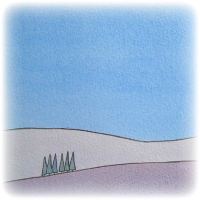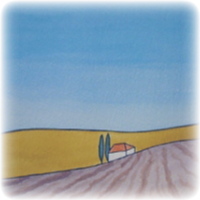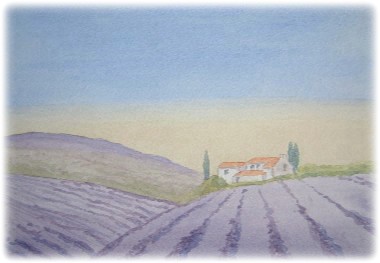Watercolour painting tutorial
Watercolor tutorial - the watercolour wash
In order to learn how to watercolour paint you will need a working knowledge of Washes. There are three types of wash: flat, graded and variegated. A flat wash produces the same amount of colour and tone across an area. A graded wash is stronger at the top than at the bottom. A variegated wash is one using two or more colours.

Prepared to give it a go? First, mix a wash of colour by loading a largish watercolour brush with clean water and with this make a small pool of water in your palette. Squeeze a pea-size blob of paint next the pool and, using your brush, add paint to the water and mix evenly. To create a Flat Wash load your brush with coloured water and, holding the watercolour paper at a slight angle, apply the brush with an even stroke across the paper. While this first stroke is still wet, make sure that you have enough paint on you brush and apply a second stroke. Repeat this until the whole area is painted. Now sit back and admire your handiwork while it dries. When fully dried the wash will be an even colour across the area. A good example is the minimal watercolour landscape to the right. Here, I applied three flat washes to good effect remembering that the lighter, colder colours are used for the distance, whereas the stronger colour are used for the foreground.

The next watercolour technique is the Graded Wash that weakens in colour, or reduces in tone, approaching the horizon. Ready to give it a try? Load your watercolour brush with coloured water and again apply it across the top of the area, holding your paper at a slight angle. The further the wash is applied down the paper, gradually add water to the loaded brush. By doing so you are weakening the colour and reducing the tone. Once the area has been covered, sit back and admire your handiwork while it dries. The watercolour minimal landscape to the left was painted using a graded wash for the sky, whereas a flat wash was used for the fields. Note how the blue of the sky reduces in tone towards the horizon, thus giving this simple but effective painting some aerial perspective. The next time that you are outside, study the sky .. the darker blue is closest to you and lighter shades are on the horizon.
 The final wash is the variegated wash, which in this exercise, uses two colours. First, ensure that you have enough of your first colour after the last two exercises and then mix a wash of a different colour. You are now ready to go. Start with a flat wash, as described above, with your first colour, then after a few strokes introduce the second colour and keep going until the area has been covered. Now sit back and admire your handiwork while it dries. I used a variegated wash in the watercolour landscape to the left, producing the effect of dawn over the Lavender Farm. Note that flat washes were used for the fields before adding the lavender detail once the wash had dried.
The final wash is the variegated wash, which in this exercise, uses two colours. First, ensure that you have enough of your first colour after the last two exercises and then mix a wash of a different colour. You are now ready to go. Start with a flat wash, as described above, with your first colour, then after a few strokes introduce the second colour and keep going until the area has been covered. Now sit back and admire your handiwork while it dries. I used a variegated wash in the watercolour landscape to the left, producing the effect of dawn over the Lavender Farm. Note that flat washes were used for the fields before adding the lavender detail once the wash had dried.
Watercolour Paintings Landscapes Minimal Landscapes Wildlife Nudes Beaches and Boats Abstract Commissions Watercolour Gallery
Latest Work
Cockington Collection Lanercost CollectionWatercolor Tutorials
Equipment Colour and Tone Watercolour Washes Wash Techniques Perspective How to Paint Trees Watercolor Tutorial 1 Watercolor Tutorial 2 Watercolor Tutorial 3 Watercolor Tutorial 4Guest Artists
James Baldwin Lucy Toft Hamish CormackCOPYRIGHT All images shown on this website are protected by copyright. No artwork may be reproduced without prior consent by the artists.
Art Links
If you have an art related website and would like to exchange links, please click here.
Art and Design
Web design by zero78


Thank you for reading about watercolour equipment. Please now proceed to the next part of this watercolor painting tutorial.